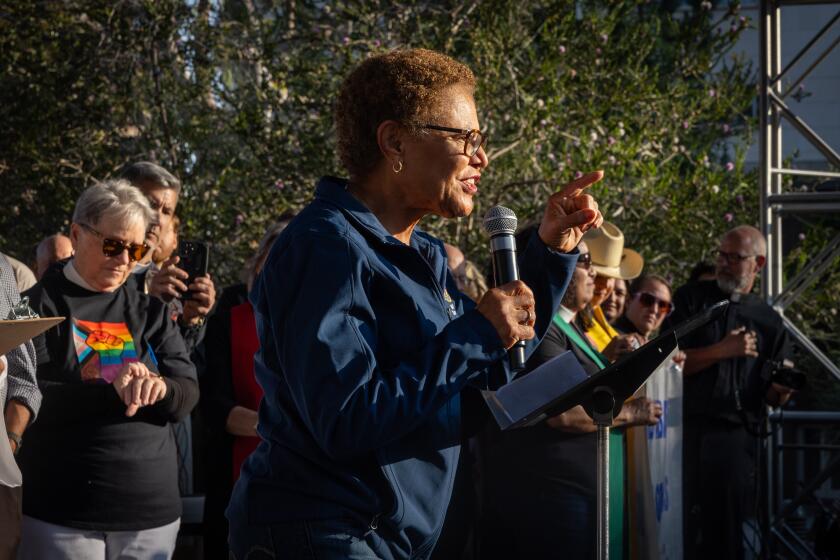Port District Bankruptcy Case Goes Before Judge
- Share via
VENTURA — The bankrupt Ventura Port District’s largest creditor charged Tuesday that officials have not done all they could to pay off more than $22 million in debt, arguing that the independent agency could have dissolved itself and turned its assets and debts over to the city.
Attorneys for Ventura Group Ventures say they will argue that point today in U.S. Bankruptcy Court in Santa Barbara, in the first court hearing on the port district’s debt adjustment plan.
Ventura’s city attorney, however, said he does not believe the city could be held liable for the port’s debts.
The district filed the plan with the court in January, four years after filing for Chapter 9 bankruptcy. The plan includes a disclosure statement, which lays out what the port district owns, what it owes, and other special conditions.
The port district is an independent agency that operates Ventura Harbor, but its five commissioners are appointed by the city. The district’s debt includes about $4 million owed to the California Department of Boating and Waterways and about $18 million owed to private creditors.
Today, U.S. Bankruptcy Court Judge Robin Riblet will hear both sides argue whether the disclosure statement is adequate. If she determines that it is, she will go on to evaluate the merits of the debt adjustment plan at a later date. Her options are to accept the current adjustment plan as filed, to order the port district to strengthen the plan or to rule that the plan is unacceptable.
Dewitt Blase, attorney for Ventura Group Ventures, said Tuesday that a state statute allows the port district to be dissolved by a unanimous vote of the five port commissioners. If that happened, all the debts and all the assets would be turned over to the city of Ventura.
“We are saying it is time to force them to do something,” Blase said. “We are telling them to dissolve, or get out of Bankruptcy Court. There is a way to pay the creditors.”
Port District General Manager Ed Wohlenberg called it a new twist in the district’s ongoing financial saga.
“Their tactic is to get into the deep pockets of the city,” he said.
City Attorney Bob Boehm, who will also be in court, said he does not believe the city could be held liable. He also said the Bankruptcy Court may not have the power to compel the port district to dissolve.
“I do not think it is legally possible to use the assets of the city to discharge the obligations of the district,” he said. “Even if the city is the successor.”
Ventura Group Ventures won a $15.7-million court judgment in 1991 for a breach-of-contract case. The district filed for bankruptcy on Aug. 20, 1993, and has not paid any of its loans since.
“They have spent roughly $5.5 million in attorney’s fees,” Blase said. “Which is more than they have spent on dredging during that time. But they have done everything to avoid paying a nickel . . . since 1993.”
The debt adjustment plan offers several options, including the sale of the entire 274-acre harbor--including the boat slips, marinas, shopping centers and a mobile home park.
A second option would be to gradually develop some parts of the harbor. The district has tried to do that for several years--with little success.
Ventura Group Ventures has argued in the past that the district should be forced to sell parcels piecemeal. But Wohlenberg and some of the commissioners have balked at the idea, saying they could be left with all the legal and dredging bills, and none of the revenue from the most productive parcels--like the mobile home park.
“Their position is, go sell two or three parcels,” Wohlenberg said last week. “But if we do that, the district will be so short of income the district can’t survive.”
Instead, the district decided to put the entire port on the market. As of last week, it had received inquiries, but no offers.
“Some claimants have constantly said, ‘Sell, sell, sell,’ ” Wohlenberg said. “To be credible in Bankruptcy Court, we have to try.”
Wohlenberg fears that many Ventura residents take the port district too much for granted.
“There is a tremendous need to wake people up,” Wohlenberg said. “This is a community asset.”
Blase says dissolve it, turn it over to the city, and then the public can decide its future.
“The public can decide what kind of services they want . . . just like the libraries, or roads,” he said. “If they don’t want a port district they can shut it down, and turn it into a sand pile. But it’s got to be a public decision.”
More to Read
Sign up for Essential California
The most important California stories and recommendations in your inbox every morning.
You may occasionally receive promotional content from the Los Angeles Times.













